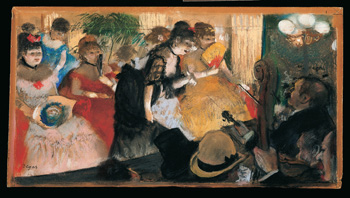1 Painting modern life
‘The painting of modern life’ was a phrase coined in the mid-nineteenth century by the French poet Charles Baudelaire to capture what was distinctive about the new art of his day. His was a dynamic culture characterised by new technology, new forms of urban life and leisure and a sense that the pace of life was quickening up.
This is an excellent opportunity to establish a rational and historical theory of beauty, in contrast to the academic theory of a unique and absolute beauty ... Beauty is made up of an eternal, invariable element ... and of a relative circumstantial element, which will be the age, its fashions, its morals, its emotions ... Today I want to discourse about a strange man, a man of powerful and decided originality ... He is looking for that quality which you must allow me to call ‘modernity’... By modernity I mean the ephemeral, the fugitive, the contingent, the half of art whose other half is the eternal and immutable.
Charles Baudelaire (1863), in Charles Harrison, Paul Wood and Jason Gaiger (eds) (1998) Art in Theory 1815–1900, Blackwell, Oxford, pp. 494–7.
Impressionism
The art that captured this life came to be known as Impressionism – an art of bright colours and rapidly applied dabs of colour that in its vivid, improvised quality somehow seemed to match the new informality and mobility of the life it depicted. Take a look at Figure 1, which is a painting by Edgar Degas.

What is the subject of this picture?
In the right-hand foreground of the picture you can see dark-clothed musicians and the heads of some members of the audience. Beyond them is a brightly-lit space in the centre of which is a standing female singer, leaning forwards slightly, towards the audience. Behind her is a colourful group of seated women. Beyond them, in the top-right of the picture, there are bright lights and what appears to be a dark exterior, the green colour perhaps indicating the light hitting some trees. This is an open-air café-concert in Paris, crowded with people, mostly men, listening to the songs, probably drinking and talking. It represents one of the quintessential sites of nineteenth-century ‘modernity’.
How is it made?
The picture is made with pastel rather than paint, coloured in over a print called a ‘monotype’. The main point here is that Degas has used sketchy, rapid effects involving blurring, lack of definition, even scratching and scraping at the surface, as well as quickly applied squiggles of the crayon, to capture the informality and mobility of the scene. The technique of the representation is closely ‘tuned’ to its content.
